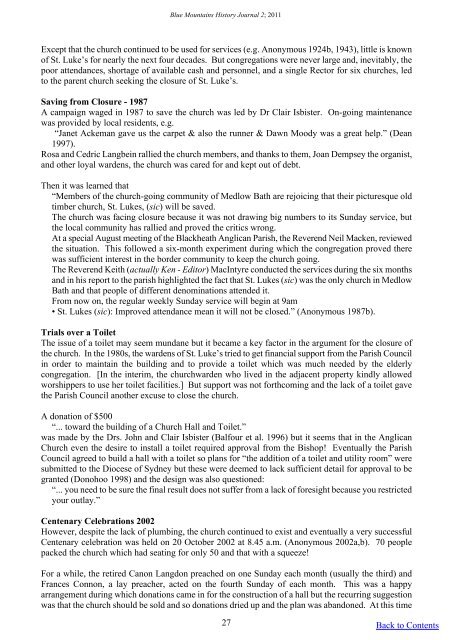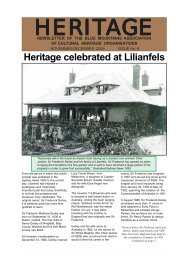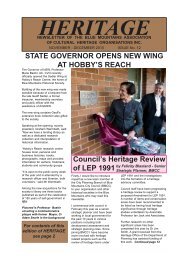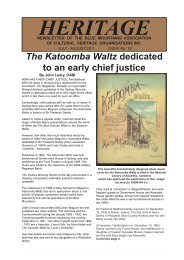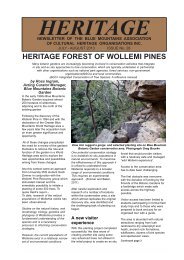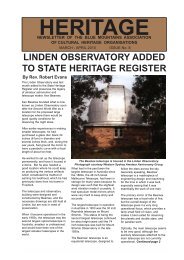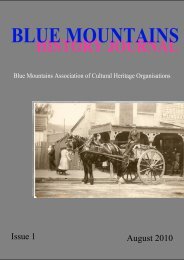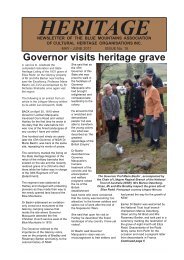Blue Mountains History Journal Issue 2
Blue Mountains History Journal Issue 2
Blue Mountains History Journal Issue 2
You also want an ePaper? Increase the reach of your titles
YUMPU automatically turns print PDFs into web optimized ePapers that Google loves.
<strong>Blue</strong> <strong>Mountains</strong> <strong>History</strong> <strong>Journal</strong> 2; 2011<br />
Except that the church continued to be used for services (e.g. Anonymous 1924b, 1943), little is known<br />
of St. Luke’s for nearly the next four decades. But congregations were never large and, inevitably, the<br />
poor attendances, shortage of available cash and personnel, and a single Rector for six churches, led<br />
to the parent church seeking the closure of St. Luke’s.<br />
Saving from Closure - 1987<br />
A campaign waged in 1987 to save the church was led by Dr Clair Isbister. On-going maintenance<br />
was provided by local residents, e.g.<br />
“Janet Ackeman gave us the carpet & also the runner & Dawn Moody was a great help.” (Dean<br />
1997).<br />
Rosa and Cedric Langbein rallied the church members, and thanks to them, Joan Dempsey the organist,<br />
and other loyal wardens, the church was cared for and kept out of debt.<br />
Then it was learned that<br />
“Members of the church-going community of Medlow Bath are rejoicing that their picturesque old<br />
timber church, St. Lukes, (sic) will be saved.<br />
The church was facing closure because it was not drawing big numbers to its Sunday service, but<br />
the local community has rallied and proved the critics wrong.<br />
At a special August meeting of the Blackheath Anglican Parish, the Reverend Neil Macken, reviewed<br />
the situation. This followed a six-month experiment during which the congregation proved there<br />
was sufficient interest in the border community to keep the church going.<br />
The Reverend Keith (actually Ken - Editor) MacIntyre conducted the services during the six months<br />
and in his report to the parish highlighted the fact that St. Lukes (sic) was the only church in Medlow<br />
Bath and that people of different denominations attended it.<br />
From now on, the regular weekly Sunday service will begin at 9am<br />
• St. Lukes (sic): Improved attendance mean it will not be closed.” (Anonymous 1987b).<br />
Trials over a Toilet<br />
The issue of a toilet may seem mundane but it became a key factor in the argument for the closure of<br />
the church. In the 1980s, the wardens of St. Luke’s tried to get financial support from the Parish Council<br />
in order to maintain the building and to provide a toilet which was much needed by the elderly<br />
congregation. [In the interim, the churchwarden who lived in the adjacent property kindly allowed<br />
worshippers to use her toilet facilities.] But support was not forthcoming and the lack of a toilet gave<br />
the Parish Council another excuse to close the church.<br />
A donation of $500<br />
“... toward the building of a Church Hall and Toilet.”<br />
was made by the Drs. John and Clair Isbister (Balfour et al. 1996) but it seems that in the Anglican<br />
Church even the desire to install a toilet required approval from the Bishop! Eventually the Parish<br />
Council agreed to build a hall with a toilet so plans for “the addition of a toilet and utility room” were<br />
submitted to the Diocese of Sydney but these were deemed to lack sufficient detail for approval to be<br />
granted (Donohoo 1998) and the design was also questioned:<br />
“... you need to be sure the final result does not suffer from a lack of foresight because you restricted<br />
your outlay.”<br />
Centenary Celebrations 2002<br />
However, despite the lack of plumbing, the church continued to exist and eventually a very successful<br />
Centenary celebration was held on 20 October 2002 at 8.45 a.m. (Anonymous 2002a,b). 70 people<br />
packed the church which had seating for only 50 and that with a squeeze!<br />
For a while, the retired Canon Langdon preached on one Sunday each month (usually the third) and<br />
Frances Connon, a lay preacher, acted on the fourth Sunday of each month. This was a happy<br />
arrangement during which donations came in for the construction of a hall but the recurring suggestion<br />
was that the church should be sold and so donations dried up and the plan was abandoned. At this time<br />
27 Back to Contents


